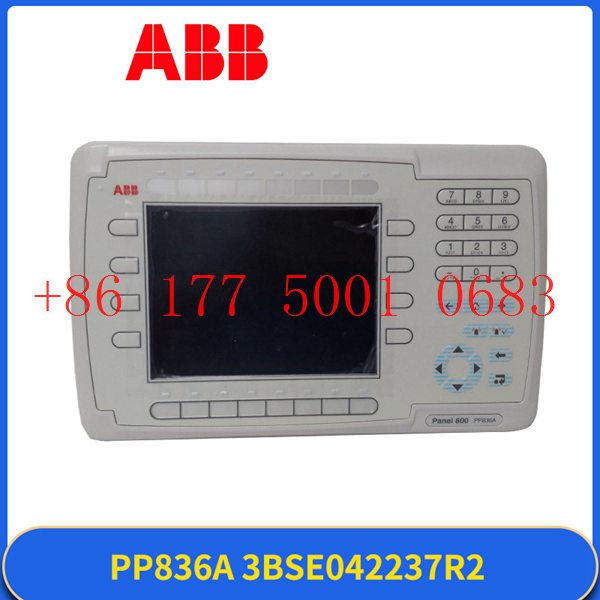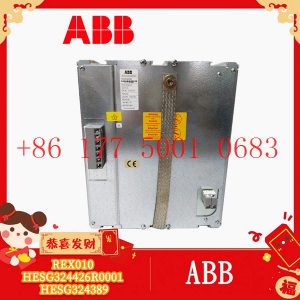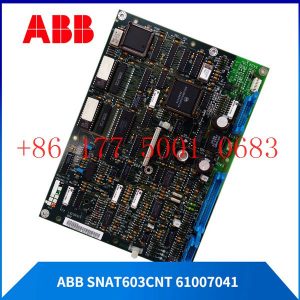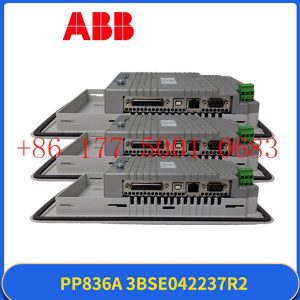Description
hardware flow control. It is an ideal choice in the field of industrial automation.
Implementation of communication between ABC industrial robot and PLC based on DeviceNet fieldbus technology
introduction
In modern production systems, industrial robots and PLCs need to communicate and collaborate to complete production tasks. That is, the
industrial robots output signals to the PLC, allowing the PLC to control related equipment to drive the robot”s front-end tools. This article
mainly analyzes the communication problems between ABB industrial robots and PLC based on DeviceNet fieldbus technology.
DeviceNet is a common network communication method in the field of automation. ABB industrial robots establish a network to communicate with
Siemens PLC based on the DeviceNet network.
1Configure DSQC652
There are mainly 5 types of standard I/0 boards commonly used in ABB industrial robots [2]. Except for the different addresses assigned to
them during setup, their configuration methods are basically the same. This article mainly analyzes the ABB standard I/0 board DS0C652, which
mainly builds communication modules based on the DeviceNet network. The DS0C652 board has a distributed I/O module with 16 digital input and 16
digital output interfaces. The board is installed in the ABB industrial robot control cabinet. First, define the specific operation steps of the DS0C652 board,
enter the teach pendant control panel, then enter the configuration menu (Figure 1), select the DeviceNetDevice menu, and add a template to enter Figure 2.
ABB standard I/0 board is hung on the DeviceNet
network, so the address of the module in the network must be set. The jumpers 6 to 12 of terminal x5 are used to determine the address of the module.
The available address range is 10 to 63. Modify the parameters in the template parameters to complete the DS0C652 board settings. Click the drop-down
menu to select the “Use value from template” row, select
“DS0C65224VDCI/0Device”, and then the parameters that need to be set include the address of the I/0 board in the bus.
Figure 1 Configuring DSQC652
2Configure signals and parameters
After completing the DS0C652 board setting, the I/0 signal setting will be performed. Setting the I/0 signal is the basis for establishing communication with
the PLC. The PLC communicates and transmits data with the ABB industrial robot through the I/0 signal and the DS0C652 board. As shown in Figure 3, in the
signal configuration interface, there are many default I/0 points after the system is established. Modification is not allowed. Click “Add” to add signals. When setting
input and output signals, their address range is 0~15. First, enter the signal menu in the configuration options to set the input and output types, and modify the corresponding parameters.
After completing the settings, the computer prompts that you need to restart the settings. If there are multiple signals that need to be defined and the waiting time
is long after restarting multiple times, you can click “Cancel” and wait for all signals to be defined before clicking the “Yes” button to restart. After the signal settings are
completed, click to select “Input and Output” in the ABB menu to check whether all signals have been set.
Figure 2 Configure DSQC652 parameters
Figure 3 Signal parameter settings
During the signal establishment process, attention should be paid to the DSoC652 port and PLC port addresses used, and the corresponding address table should be
established, as shown in Table 1. The robot interacts with the PLC through I/O signals. During the setting process, there must be no errors in the port and address number
of the PLC connected to the DSoC652. If the address is set incorrectly, the communication between the robot and the PLC will not work properly.
The entire robot teaching pendant setting process is shown in Figure 4.
https://www.xmamazon.com
https://www.xmamazon.com
https://www.plcdcs.com/
www.module-plc.com/
https://www.ymgk.com
RELIANCE O-57430 Processor module
RELIANCE O-57428 Toledo Scale Interface Modul
RELIANCE O-57423 Automax Memory DCS Module
RELIANCE O-57420 5-24 VDC Output Module
RELIANCE O-57419- 5-24 VDC Input Module
RELIANCE 805427-1S Resistance scaling module
RELIANCE 805405-5R Field power module
RELIANCE 805405-3R SF3000 Single-Phase Field Power Module
RELIANCE 805405-1R Power Module
RELIANCE 805403-3R field power module
RELIANCE 805403-2R Resistor Scaling Module
RELIANCE 805403-1R Resistor Scaling Module
RELIANCE 805402-R Automax Distributed Power System
RELIANCE 805401-S 3-Slot PMI Rack assembly
LAM Research 605-109114-004 GE V7668A-132L00W04 4-Port Gigabit Ethernet Card Module
RELIANCE 805401-7R 4-Slot Parallel Gate Amplifier Rack
RELIANCE 805401-3S AutoMax Distribution Power System
RELIANCE 805401-2S Power Module
RELIANCE 804100-RX Remote I/O Head module
RELIANCE 804100-RV complete module
RELIANCE 61C613 analog input module
RELIANCE 61C605 8-Channel Isolated Thermocouple Module
RELIANCE 61C544 RTD module
RELIANCE 61C542 16 Channel Input Module
RELIANCE 61C516 AC/DC Input Module
LAM Research 605-048878-001 GE FANUC VME-7671-421000 SBC Board
RELIANCE 61C540 16-Point Input Module
RELIANCE 61C515 16-Bit Input Module
RELIANCE 61C501 Input Module
RELIANCE 61C500 module
RELIANCE 61C366 Analog Output Module
RELIANCE 61C351Input module simulates track card
RELIANCE 61C365 Output Module
RELIANCE 61C351 Input Module Analog Rail Card
RELIANCE 61C350 I/O Module
RELIANCE 61C345 Analog Input Module
RELIANCE 61C346 Analog Rail created
RELIANCE 61C326 PLC interface module
RELIANCE 61C23 AutoMax Local I/O headers created by the DCS system
RELIANCE 61C22 Local I/O Head made
RELIANCE 58820 AutoMax DCS system designed by MBCN
RELIANCE 57C570 AutoMax PC3000 Processor
RELIANCE 57C565 Optional string andante
RELIANCE 57C560 PC3000 processor









Reviews
There are no reviews yet.